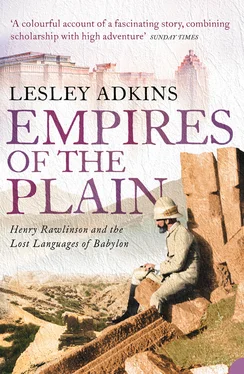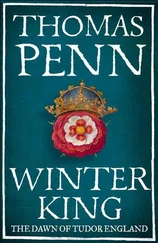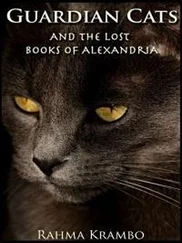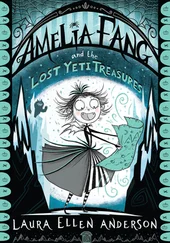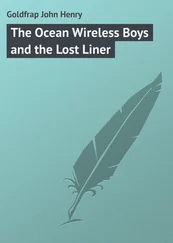Rawlinson also explained in his letter that he had seen the results of Grotefend and Saint-Martin, but that much of the work of these two scholars was flawed, and that out of forty Old Persian cuneiform signs, he had discovered the meaning of around thirty and was also analysing the language, using clues from Zend and Sanskrit. He went on to describe how the inscription at Bisitun related the eastern victories of Darius and said that he was working on its most simple script. For now, he sent the society a transcription and translation of the opening two paragraphs (the titles and genealogy of Darius the Great), with a promise to send much more if they were interested.
The long letter was received in London in March. While other scholars in Europe were unknown to Rawlinson, he himself was unknown in England. The reply to him in early April by Major-General John Briggs, Secretary of the Royal Asiatic Society, demonstrated the genuine interest and enthusiasm of the society and a willingness to encourage and guide this young scholar ‘removed from the information which European libraries and scholars might afford you if on the spot’. 7 Briggs first of all emphasized ‘that the Society is extremely happy to learn from you that there is a prospect of obtaining the contents of the cuneiform tablets … and it will thankfully receive and publish anything new which you may have the goodness to send on the subject’. 8 Briggs went on to say that he had written to Dr Julius Mohl of Paris, an Oriental scholar who had been acquainted with Saint-Martin, entreating him to contact Eugène Burnouf, ‘one of the most profound Oriental scholars in Europe, and I believe the last who has occupied himself in translating the cuneiform character. He has succeeded in making out (according to his own alphabet, and from his thorough acquaintance with the Sanscrit and Zend languages) two inscriptions, one procured at Murghab, near Hamadan [Elwand], and the other at Van … His alphabet differs from that of Professor Grotefend and M. St. Martin, and, as you have both these, I believe, I now send that of Burnouf, showing the differences between it and those of his predecessors in the same study.’ 9
There was a genuine sense of excitement as word about Rawlinson’s achievements spread through the academic community, and a few days later his translation was exhibited to the Société Asiatique in Paris. His work was perceived to be so pioneering that, on 21 April, the Royal Asiatic Society informed him that he had been elected an honorary Corresponding Member, and the Société Asiatique did the same soon after. Mohl and Burnouf also sent copies of additional relevant publications to London for the Royal Asiatic Society to forward to Rawlinson.
At a meeting in London in May, the Royal Asiatic Society recorded: ‘Among other subjects of congratulation the Council cannot refrain from noticing the discovery made by our countryman, Major RAWLINSON, (at present in the army of the King of Persia) of vast tablets existing in various parts of that country, covered with cuneiform inscriptions, some of which contain a thousand lines each. The Society is aware of the efforts which have been made by some of the most learned Orientalists in Europe to decipher these inscriptions – efforts in which they have only partially succeeded hitherto, but which, through the energy of Major Rawlinson, and the aid of which he will be able to avail himself in the published Transactions of Messrs. Grotefend, St. Martin, Klaproth, Müller, Rask, Bellino, and Eugene Burnouf, may, it is hoped, be crowned with success.’ 10
Their report continued with the significance of Rawlinson’s discoveries: ‘A remarkable feature in the translation of a portion of one of these inscriptions, sent to the Society by Major Rawlinson, is the fact that the genealogy of a race of kings found on a tablet (which records, as he informs us, the conquests of Darius Hystaspes), corresponds very closely with the list of the same line of monarchs given in the seventh chapter of the second book of Herodotus. It is not, therefore, too much to hope that at no distant period, the mysteries of these inscriptions may be developed, and it seems probable these interesting monuments may throw additional light on the ancient history of Persia, beyond what has been transmitted to us by Greek authors.’ 11
Scholars were especially willing to extend every assistance to Rawlinson, because of the prospect of verifying Herodotus and increasing their knowledge of ancient Persia. They had no idea that the decipherment of cuneiform would also lead to momentous revelations about virtually unknown civilizations in Assyria and Babylonia. The society announced that Rawlinson had been urged ‘to devote himself, in the first place, to obtain copies of all the cuneiform inscriptions which are procurable in Persia, and to send one set for deposit in this Society’. 12 A long relationship with the society developed, with Rawlinson frequently communicating his latest results by letter.
That summer, on 28 June 1838, the coronation of Queen Victoria took place in London, while in Tehran, Rawlinson received Burnouf’s report on the Elwand inscriptions, Mémoire sur deux Inscriptions Cuneiformes trouvés près d’Hamadan , that had been published two years earlier. He was disappointed to discover that he was not the first to copy and study this inscription and that Burnouf had pre-empted his own work. In the report, Burnouf discussed the work of other scholars on Old Persian cuneiform and reproduced the alphabet that Saint-Martin had worked out, commenting: ‘M. Saint-Martin assured me more than once that he believed his system of decipherment beyond criticism, at least in its general results. According to him, what still needed to be made clear were both the language in which these inscriptions was written … and the two other systems of writing to which he had given the names Median and Assyrian .’ 13 Nevertheless, Burnouf suggested a new alphabet of his own, thirty letters in all with three uncertain ones.
Rawlinson’s own work did not completely coincide with Burnouf’s, and he disputed several points: ‘The memoir of M. Burnouf on the Inscriptions of Hamadán [Elwand] … showed me that I had been anticipated in the announcement of many of the improvements that I had made on the system of M. Saint Martin, but I still found several essential points of difference between the Paris alphabet and that which I had formed from the writing at Behistun, and my observations on a few of these points of difference I at once submitted to M. Burnouf.’ 14 On 30 July Rawlinson wrote again to the Royal Asiatic Society, enclosing a long letter to Burnouf in Paris, which gave his own Old Persian alphabet and extensive copies of the cuneiform inscription at Bisitun. He explained to the Royal Asiatic Society that he was waiting to receive Burnouf’s report on the Yasna ‘before I forward you my copy and attempted translation of the great Bisitoon inscription. I have still thought it advisable to lose no time in putting myself in communication with that gentleman with a view to defining the exact points of coincidence and variance between our respective alphabets of the Cuneiform character. I have therefore written him a letter upon the subject which I forward to your address, and as it is possible that discussions may hereafter arise regarding the priority of claim to the determination of certain characters, perhaps you will kindly allow the letter to be copied and preserved among the records of your society.’ 15 Rawlinson explained that once he had received the Yasna and tested various points, ‘I trust to be able to bring my remarks on the Bisitoon Inscription to a state that will enable me to send off a considerable portion of the copy and translation by the next courier’. 16
Читать дальше
